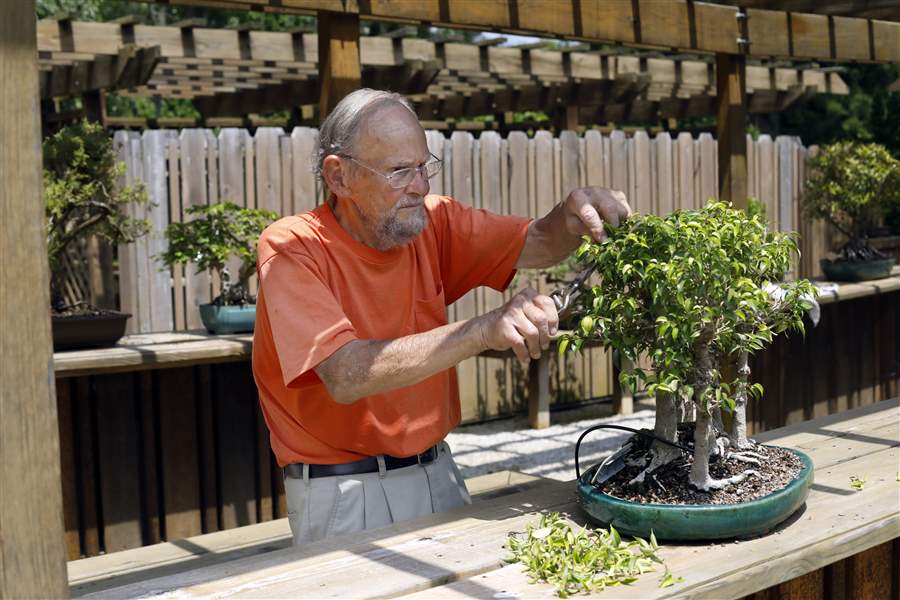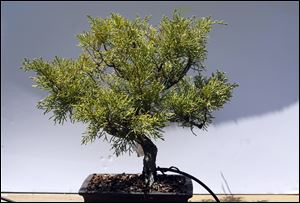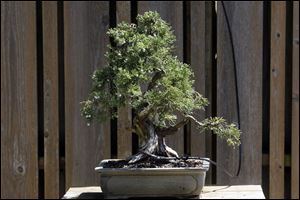
Living art: Tiny trees are big passion for local bonsai specialist
7/7/2018
Leo Pelka, 86, trims several ficus bonsai during his weekly visit to Schedel Arboretum and Gardens.
The Blade/Katie Rausch
Buy This Image
ELMORE — Every Thursday morning, 86-year old Leo Pelka visits the Schedel Arboretum and Gardens in Ottawa County to tend to his bonsai plants.
Mr. Pelka’s fascination with bonsai developed 25 years ago after his wife introduced him to her gardening club. He soon bought his very first juniper bonsai at a flower shop in Cleveland. A month later, the plant died.
"What I found out after it died was that it’s an outsider in the cold,” Mr. Pelka said.

Leo Pelka
The same pattern repeated itself when Mr. Pelka bought his second bonsai. Four years later, he perfected the art of bonsai upon the passing of his wife.
Bonsai is an art form developed in China in the 5th century and later perfected by the Japanese that involves careful cultivation to produce small trees that mimic the shape and scale of full-size ones.
It all started with the gardening club’s president asking him if he knew anyone interested in taking care of bonsai.
“I thought, ‘Why not? I have time on my hands,’ answered the call, and came here,” Mr. Pelka said.
“Here” is the sprawling 17-acre grounds of the Schedel Arboretum and Gardens, where he has volunteered for the past 20 years. When Mr. Pelka began volunteering, there were only 30 bonsai trees at Schedel. Since then, the bonsai shelter — subsequently named for Mr. Pelka — has expanded to house 300 trees of all sizes and varieties, including evergreens, Indian hawthorn, Japanese maple, and more.
On a typical day, Mr. Pelka comes to the garden with his friend Steve Tusen to trim and place wiring on the plants to give them style and character. The trees are trained and pruned into familiar shapes.
Since the arboretum doesn’t have any other volunteers to look after the miniature trees, an irrigation system waters the bonsai. On warmer days, Mr. Pelka saturates the plants. The holes at the bottom of the pots allow water to drain, letting the plants shed excess moisture.
In the fall, he checks the pots with chopsticks to discern the density of the roots. Afterward, he moves bonsai varieties that are typically found outside to an area where direct sunlight can’t reach the plants as they grow dormant during winter.
Mr. Pelka said the most important part of maintaining bonsai is making sure the roots are properly hydrated. Larger plants are usually watered twice a day, depending on the size of the pot.

A juniper bonsai tree is on display at Schedel Arboretum and Gardens in Elmore.
“If you’re just starting out, indoor plants are a great way to play around,” said Kurt Smith, owner of Flower Market in Dundee, Mich. Mr. Smith started planting bonsai as a hobby and has now been doing it for 30 years. His is the largest bonsai nursery in Michigan.
Rachel Machon of Bensell Greenhouse in Toledo said that bonsai have a coarse bark, and the plants dry out or stay wet longer, depending on temperature.
Some bonsai can be kept outdoors. Junipers, for example, must be buried outside in the winter to spur seasonal dormancy.
"It’s like getting a puppy. You’re attentive to that puppy until you develop habits for it, and the same thing will happen with a tree,” Mrs. Machon said. “After a while, you start to look at it and think the coloring is fading and realize it needs water or fertilizer, and all of a sudden you become very aware of the needs of the tree.”
She added that bonsai care has to be adjusted to the climate in Toledo. Tropical bonsai work best indoors, as they can withstand indoor temperatures all year long. The rest of the maintenance involves trimming and styling, with the foliage being cut early in the spring.
The shape of the trees can be manipulated through wiring, Mr. Pelka said. The usual style is an offset triangle, with one side larger than the other and the apex grown directly over the roots. In case a branch grows beyond another, it can easily be cut to make the plant more stylish, he said.
With a bonsai, the roots and foliage are trimmed often to keep the tree from developing its tap root, the main vascular system that goes deep into the ground to catch water. The process involves lifting the roots out of the pot, raking them out, and trimming them. Shallow, fine roots are allowed to spread throughout the pot, allowing the trunk to expand and keeping the tree in constant growth, Mrs. Machon said.
Mr. Pelka said it’s important to give the tree four to five years to develop before turning it into bonsai.
“That’s the fun in it: the maintenance on it,” the veteran caretaker said. “The fun is putting the wire on, starting out with a smaller plant, watching it grow, styling it, and then you get a tree that’s 40 to 50 years old and be able to walk away with it. That makes it an amazing thing.”
He said bonsai trees need to be repotted every few years so the roots don’t circle around themselves.
"It takes a certain amount of bravery and certain amount confidence to do that,” Mr. Pelka said. “Otherwise, if you don't do it right, you end up killing the plants.”
There are several styles of bonsai, including cascade, slanting, broom, and multi-trunk. These various styles can be reached while experimenting with different sizes of pots and wiring.
“It doesn’t matter what kind of plant you have, you can make a bonsai out of it if you catch it soon enough, and if it’s big, you just whack it all down and start fresh to develop it,” Mr. Pelka said.
Mr. Pelka said the two most important things to keep an eye on are the water intake of the plant and the root structure. Once those are taken into account, bonsai are like any other trees.

Leo Pelka, 86, trims several ficus bonsai during his weekly visit to Schedel Arboretum and Gardens.
He said his favorite part about maintaining bonsai trees is finding inch-long cuttings and eventually growing them into miniature trees. He tries searching for trunks that are half dead or good plants people are trying to get rid of. He then takes those plants, cuts them down to their trunks, and fits them into small boxes.
If a plant survives, it can be grown into a bonsai that can be passed down for generations.
“Sometimes it’s the process of doing the bonsai that is really healthy for people [rather] than just seeing the end result,” Mrs. Machon said. "You don’t really have a finished bonsai ever.”
She said bonsai can live a very long time. For example, the national arboretum in Washington has an entire section of bonsai trees with the youngest being 300 years old.
Mr. Pelka said the trees he has at home are about 10 to 12 years old. He’s learned that trees don’t necessarily develop the way you want them to, because sometimes nature has its own design.
Mr. Pelka loves bonsai so much, he financed, designed, and helped supervise the construction of the shelter at Schedel that bears his name.
"This is my life,” he said with a satisfied smile. “I seriously believe I wouldn’t be here if I didn’t have bonsai.”